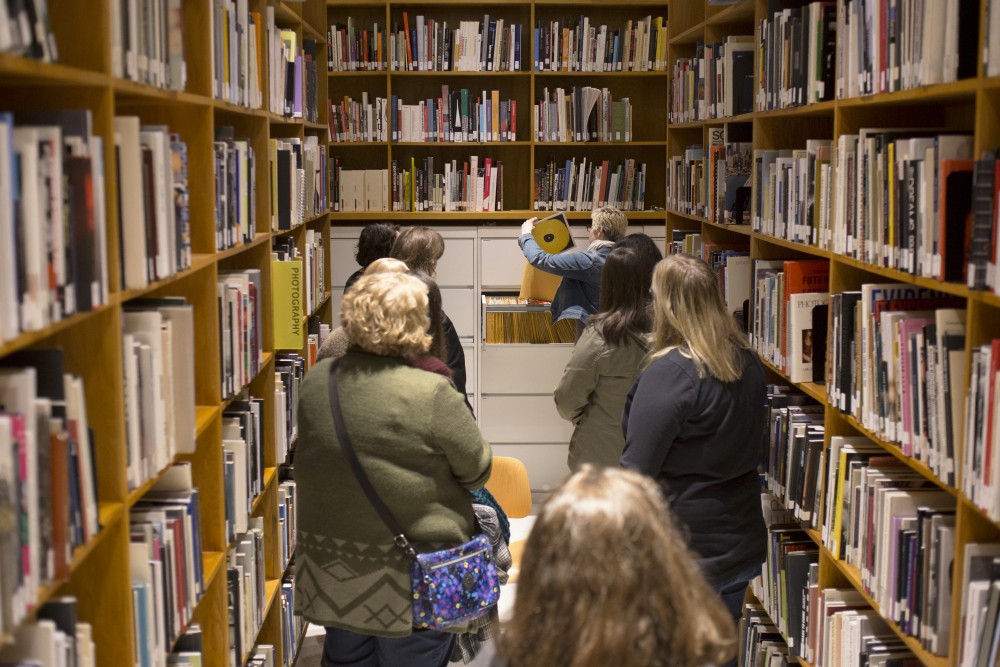What makes a museum? At the Walker Art Center, the public rarely sees what’s behind the gleaming white walls, curated exhibitions and pristine panels and labeling.
In addition to its exhibitions and permanent collection, the Walker holds a rich selection of contemporary art books and archival materials that are consistently used for research and reference. Saturday morning, the art center opened their library and archives for a public tour initiated by St. Kate’s Society of American Archivists Student Chapter.
Led by Head of Archives and Library Jill Vuchetich, the first stop was the Walker Library. Comprising a large study table and wooden shelves stacked to the ceiling with books and periodicals, the seemingly small library contains over 35,000 contemporary art books, 150 art journals, 1,800 artist books and 5,200 art files.
“It’s a small library, but for a contemporary art museum it’s actually a very large collection of contemporary art books,” Vuchetich said.

In the contemporary art field, published books about artists and exhibitions are difficult to come by. Artists collected and exhibited by the Walker often have small monographs, articles or gallery guides, but they don’t necessarily have informative books that could be found in an encyclopedic art library.
“In that sense, it’s a very large but very focused library,” Vuchetich said.
Vuchetich then led the group to the archive room, which turned out to be even smaller than the library. It contained a few work spaces, large Mac desktops and grey storage boxes. The group took a seat.
“Everything in the Walker Art Center is documented,” Vuchetich said.
A popular way for the Walker to archive its material has been in the form of slides. Vuchetich demonstrated by bringing a tiny slide — perhaps 2 by 2 inches — over to a large light table for viewing.
“Other museums, libraries and archives may have gotten rid of their slides. We would never get rid of our slides in the original format. I can’t tell you how many times a day I actually go to the slides,” Vuchetich said.
The oldest materials in the archives date back to 1870 from the T.B. Walker Art Collection and include a brass gong that was used to signal closing time to visitors of the gallery.
The most valuable pieces in the archive belong to the Rosemary Furtak Collection.
“This collection contains multiples, artists’ books and rare books. We have nearly complete collections of artist books for Ed Ruscha, Dieter Roth and Sol Le Witt, as well as a collection of local artists including Thomas Rose, Phillip Gallo and Harriet Bart,” Vuchetich said.
Vuchetich and her associates frequently consider how to best collect artists’ archives, and what to do with them. Especially for installation art, documenting records for the archives proves crucial.
“Even if we commission it, that doesn’t mean we acquire it,” Vuchetich said. “In those cases, the archival material is extremely important because we have the only record of it. That becomes a really big reason why the archives are so important to this institution. We have to be the record for the work.”
Many visiting artists additionally make an effort to visit the library and archive for their research and inspiration. For students interested in the arts, the Walker Library and Archives offer an abundance of information on artists within the visual arts, performing arts, moving image and design. Among these artists are Merce Cunningham, Bruce Conner, Bruce Weber and Katherine E. Nash.
The Walker Library is non-circulating, but open to the public the first Saturday of each month from 10 a.m. to 3 p.m. and the third Thursday of each month from 5 p.m. to 9 p.m. The archives are accessible by appointment only.








